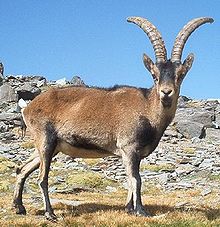Ungulates
| Ungulate Temporal range: Paleocene-Recent, 66–0 Ma Possible Late Cretaceous-Present |
|
|---|---|
 |
|
| Donkey, Equus africanus | |
 |
|
| Spanish ibex (Capra pyrenaica) | |
| Scientific classification | |
| Kingdom: | Animalia |
| Phylum: | Chordata |
| Class: | Mammalia |
| Clade: | Scrotifera |
| Clade: |
Ungulata Linnaeus, 1766 |
| Orders and Clades | |
|
|
Ungulates (pronounced /ˈʌŋɡjəleɪts/) are any members of a diverse group of primarily large mammals that includes odd-toed ungulates such as horses and rhinoceroses, and even-toed ungulates such as cattle, pigs, giraffes, camels, deer, and hippopotami. Most terrestrial ungulates use the tips of their toes, usually hoofed, to sustain their whole body weight while moving. The term means, roughly, "being hoofed" or "hoofed animal". As a descriptive term, "ungulate" normally excludes cetaceans (whales, dolphins, porpoises), as they do not possess most of the typical morphological characteristics of ungulates, but recent discoveries indicate that they are descended from early artiodactyls. Ungulates are typically herbivorous (though some species are omnivorous, such as pigs), and many employ specialized gut bacteria to allow them to digest cellulose, as in the case of ruminants. They inhabit a wide range of habitats, including jungles, plains and rivers.
Ungulata, which used to be considered an order, has been split into the following: Perissodactyla (odd-toed ungulates), Artiodactyla (even-toed ungulates), Tubulidentata (aardvarks), Hyracoidea (hyraxes), Sirenia (dugongs and manatees), Proboscidea (elephants) and occasionally Cetacea (whales and dolphins).
...
Wikipedia
